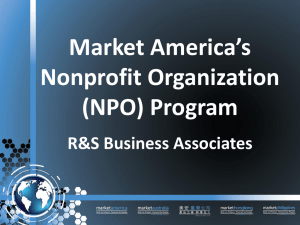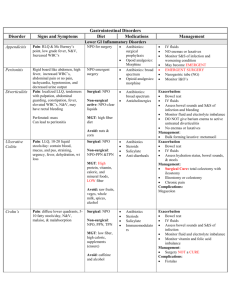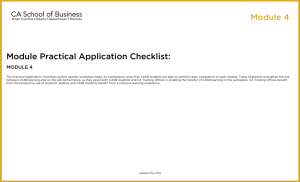HR 4.1
advertisement
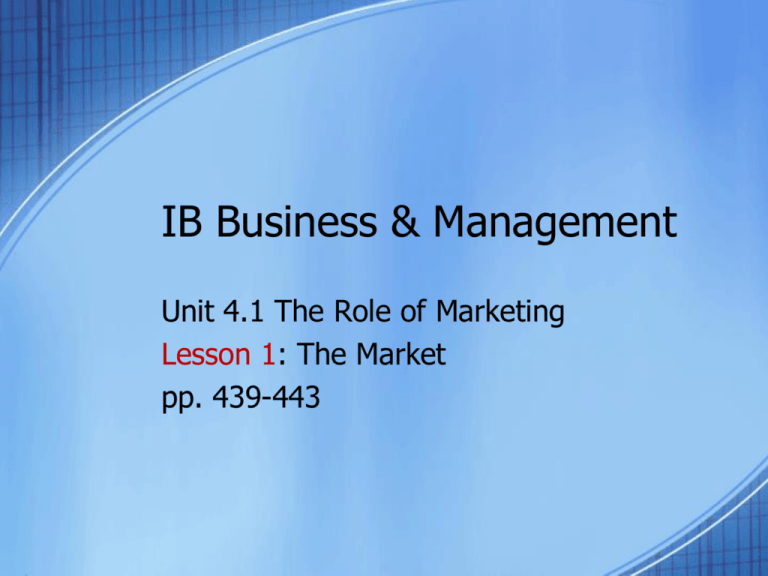
IB Business & Management Unit 4.1 The Role of Marketing Lesson 1: The Market pp. 439-443 1. Think about it… • “The greatest pleasure in life is doing what people say you cannot do.” – Walter Bagehot (1826-1877), British journalist – – – – Why do you think he said this? How does this pertain to marketing? What do you think? … 2a. An overview… • Remember back in Unit 1.1 and 1.2, talking about NEEDS and WANTS? – Needs are? • Necessities you must have to survive: food, shelter, water, NOT your cell phone! – Wants are? • The desires you have: nice car, cell phone, new computer, etc. • Marketing addresses people’s needs and wants. – It is about making customers want to buy a product. – Looks at the reasons why people decide to buy • The price, color, size, special feature of the product. – Marketing takes a want and turns it into a need. – … What is marketing? • Marketing is the process of researching into identifying consumers needs and employing appropriate price, product, place, and promotion strategies in order to satisfy these needs profitable. • Marketing is the process of learning about your customers and competitors, so that you can provide the right products at the right price in the right place, promoted in the right way to achieve your business objectives. Key elements of marketing? • Customers are of vital importance • Marketing is a process. It does not have a start or end, but is ongoing. • Involves building relationships with customers • Is a business philosophy. It’s a way of thinking about how to satisfy customer’s needs. • Affects all aspects of a business. • Is not just about selling. • Marketing and advertising are not the same. • Must satisfy consumer wants profitably. 2b. An overview… • • To create a product based on a person’s need. – Think about this: • Do you know this man? • Bob Marley (1945-1981) – Once said that he did not NEED a BMW. – So, you are in the marketing department… • How are you going to turn this product into a need? The 4 P’s of marketing and your departments main objectives are: – Products – Price – Place – Promotion – … 3a. The Market • What is it and why is it important? – It is a place where customers and suppliers trade. – It exists where there is a demand for a product and business try to satisfy that demand. • Two kinds of markets: – Consumer markets: the general public – Industrial / Commercial markets: business and governments • Within each market there will be rival products and suppliers. – Each business will be interested in three things: • 1. the size of the market • 2. the growth rate within the market • 3. the firm’s share of the market. – Lets take a closer look at each one…. 3b. The Market: Market Size • Markets will differ in size. – For example let’s look at the fast food industry… • Is there room for growth? Why do you think so? – What about the car industry? – What about the market for horse saddle’s? • Now, the market size can be measured in a number of ways: – A. Customer base: • The total number of potential customers for a business: – Think about expanding into China…how many people live there? A business selling rice in China has more potential customers than a business selling rice in a small town in the U.S.? – Think about an online business and the internet. How many people does the internet serve? – … 3c. The Market: Market Size – B. Barriers to entry: • Determines the number of suppliers in the market. • Some markets are hard for businesses to enter. – Think about entering the oil or aircraft industry…easy to do? Huge start-up costs. • Low barriers to entry means more firms/suppliers entering the market. • High barriers to entry means less firms/suppliers entering the market. – C. Location, Location, Location : • Some markets focus on certain countries / regions. • Some businesses operate all over the world. • Do you know Adidas? – They are the market leader in Tae Kwon Do equipment. 3d. The Market: Market Growth • Refers to an increase in the size of the market over a period of time. – This is measured by an increase in the value or volume of sales in the market. – For example: • If sales revenue in a market rises from $200 million to 220 million, the market is to have grown by 10%. • Market growth is given as a % • Higher market growth will lead to an increase/decrease of suppliers entering the market? INCREASE • … Market Growth • Social Changes – – – – Eating Out Smoking Organic Global Warming Market Growth • Ability of suppliers to meet customer needs – Movie Cinema market Market Growth • Technology – – – – Computers Internet Mobile Phones Blackberry 3e. The Market: Market Share • • • There are many rival products and firms in the market within any given market. Your business also contributes to this market share. But by how much? – Market share = sales revenue of firm x 100 total sales revenue in market If you increase your market share you will increase your profits. – But having the largest market share might not be the most profitable. Think about your costs • Other benefits to having a larger market share: – Status being number one; a market leader. – Economies of scale – Pricing power – So how do you increase your market share? • Promotion of brands (Unit 4.3) • Product development (Unit 5.6) • Motivation / training (Unit 2.5) • Establish property rights (Unit 3.5 and 5.6) • Use more efficient channels of distribution (Unit 5.6)… Market Share • Market concentration – measure the degree of competition within a market – Calculate market share of the largest firms in a market – 98% market concentration ratio means the top 3 firms in a particular market account for 98% of the industry’s output. – Therefore, this market is not competitive. – Most industries are dominated by a few large businesses – oligopolists. • Each firm accounts for a large proportion of the industry’s overall sales revenues. • EX: Nokia, Motorola, Samsung, Sony-Ericsson • Nike, Adidas and Reebok control 86% of world shoe market Market Leaders • Apple: For their innovation with the iPhone and now the iPad • Baidu: For their dominance in the fast growing Chinese internet market • Amazon: Leader in online retailing • Netflix: Their leadership in online streaming of video • Cree: For their leadership of the growing LED market • Priceline: Leader in the fast growing internet travel sector • Sandisk: Flash memory card leader 4a. The Nature of Marketing • There is no single, set definition of the term marketing: – Marketing objectives are different for every firm. • Marketing objectives of non-profit organizations are different from those of large multinational companies. – Most widely used definition: the management process involved in identifying, anticipating and satisfying consumer requirements profitably. – It is all about being FIRST in the mind of the consumer. – Don’t believe me? Think about it, • Who was the second man to walk on the moon? • Who was first to invent the car? Who was second? • Who was the second person to fly across the Atlantic? • … 4a. The Nature of Marketing • Marketing involves identifying the ____ & ____ of customers. – This is done through market research and data analysis. • Predicts what customers might want in the future. – Product development and innovation. i.e. cell phones, laptops, HD tv, movie industry • Must satisfy the consumer – Represent value for $. Satisfied customers become loyal customers. • About making a profit. – Prices must cover costs. 4b. The Nature of Marketing • Marketing will either make or break a company. – It will affect the sales and profits of the organization. – Marketing alone will not guarantee success either; marketing must work with other functional areas within a business such as: • Operational management: – The production department will work very closely with the marketing department. Why? – Will use sales forecasts to prepare production schedules. – Work together to research, develop, and launch products – CONFLICT: production managers prefer longer time period to test products. Marketing managers prefer quick launch to maximize sales revenue. • Delays in launch means a loss in sales 4b. The Nature of Marketing • Finance: – Together they will set appropriate budgets. – CONFLICT: marketers may want to exceed budgets to get maximum marketing exposure. Finance dep’t will want all dept’s to work within their budgets. • Human resource management: – Marketing data can help this department to identify staffing needs. HOW? – HRM role is to ensure the business has the right quantity and quality of workers to meet the needs of their customers. • … IB Business & Management Unit 4.1 The Role of Marketing Lesson 2: Market & Product Orientation pp. 444-450 1. Product Orientation • • Marketing has changed over the years from: – product-orientated (getting customers to buy the product) to – market-orientated marketing (meeting actual needs or desires of customers). Product orientation: – Is inward looking. – The focus is on selling products that a company makes, rather than making products they can sell. – Businesses hope the customers will buy their product. – EX: automobile, tv, cell phone, internet, MP3 players – all unknown to the mass market until they were launched – Say’s law: “Supply creates its own demand.” Meaning: products are launched then customers are tempted to buy them. • Hit-and-miss http://money.cnn.com/galleries/2007/biz2/0706/gallery.launch_hits_and_misses.biz2/i ndex.html 1. Product Orientation • Concept today is customers will pay higher prices for a higher quality or luxury good. • Product-oriented businesses will produce products that they have an expertise in. – EX: Ferrari producing sports cars. Airbus producing aircrafts. – BENEFIT: quality can be assured and more control over its activities. – These companies assume to know what you, the customer wants. – This is a very risky strategy to employ. • You will find out very quickly that you will need, when developing products, to take the customer into consideration. • … 2. Market Orientation • Also called Consumer orientation. – This approach is outward looking – Focus on making products that a business can sell, rather than selling products that they can make. – Main focus is on the consumer in order to: • Identify • Design • Develop and • Supply products to meet their needs and wants of customers. • How do you gather this information? Market research. • Pricing decisions are taken into account after studying customer’s level of income. • If you ignore your customer, you will lose competitiveness. 2. Market Orientation • Market changes force many businesses to be sensitive to the needs/wants of consumers. • EX: increased use of the internet. • If the consumer is ignored, firms will lose competitiveness in the market. • Now businesses are providing added facilities to meet the needs of customers. • EX: restaurants, play areas in malls, free parking • Businesses do not worry about these extra costs, instead worry more about the cost of NOT doing these things. 2. Market Orientation • – Two main advantages to using this approach: • Flexibility: respond quicker to changes • Less risk: by conducting market research, you will have a greater success meeting the wants and needs of your customers. DISADVANTAGE: Market orientation approach tends to be expensive because of the market research. – No guarantee this approach will lead to success. • So how can you decide which approach to use? It will depend upon: – The market: highly technical products vs. mass consumer market products. – Organizational culture: “the customer is always right” – market oriented. – Nature of barriers to entry: not much competition – less customer focused. EX: monopolies – product orientated – … 3a. Marketing of Goods & Services • What is a service? – Is an intangible product • EX: train ride, hair cut, going to the movies, tutoring • There is no ownership of the product and it is perishable. • Services are heterogeneous – Customers pay for services in order to fulfill wants and needs. • Can you think of any services that would fulfill a want or a need? • Marketers will use the 4P’s (marketing mix) for goods; the marketing of services includes three additional elements: – 1. People – 2. Processes – 3. Physical evidence. • Together these form the 7 P’s in the marketing mix. 3b. Marketing of Goods & Services • People: – Remember services depends on the goodwill of all employees. – How can you ensure good service: • Appearance and body language • Aptitudes and attitudes • Feedback • Efficiency • Processes: – Refers to the way in which a service is provided and delivered. – If you are selling a service how do you demonstrate to customers the benefits of services? • Payment methods • Waiting time • Customer service • After-sales care 3b. Marketing of Goods & Services • Physical Evidence or environment: – Refers to the tangible aspects of a service. • What’s in a 5-star hotel? What do you see when you first walk into a place like this? • Peripheral products • Challenges facing you as a manager in delivering quality customer service: • Correcting mistakes • Measuring productivity • People management •… IB Business & Management Unit 4.1 The Role of Marketing Lesson 3: Marketing in NPO pp. 450-454 1. NPO’s • Charities, religious organizations, government departments • Do NPO’s use marketing as part of their strategy??? YES! – Marketing is used to raise awareness about their cause • Marketing in NPO’s is somewhat different than the market-led strategies by profit seeking companies. – Tends to be more informative (not persuasive) – They use social marketing strategies: • Main goal is not to make a profit, but for the public to take action. – Donating money, recycling, protect environment • Marketing is used to sell a vision, mission, or cause • Governments and other departments are opting to use this strategy. – Military/police use marketing to enhance their image to help hire new recruits 1. NPO’s – They will also use catchphrases or slogans as a strategy. • “Your Country Needs You”, a slogan during WWI in England. – Kotler, a marketing guru, coined the term de-marketing: • the use of marketing to reduce the demand for socially undesirable products, EX: tobacco, drunk driving – Funding can be a huge problem for NPO’s, they will use public relations to give them a better public image, to increase awareness. • Charities hold fund-raising events or celebrities/heroes to endorse their cause • Hold press conferences to get message to the media • Send representatives to schools to communicate their cause 1. NPO’s – Other marketing tools used by NPO’s: • Internet has help to cut marketing costs down for the NPO’s. – Cost-effective; EX: online newsletter and/or facilities to make donations online – http://kidswishnetwork.org/programs/ – http://www.redcross.org/ – They will also strive to increase their distribution channels (Unit 4.6) • Red Cross has donation boxes in retail outlets – Summary: • NPO’s use many approaches in their marketing: – Social marketing, slogans, de-marketing, public relations, celebrity/hero endorsements, and internet technologies NPO’s • Salvation Army – http://www.salvationarmyusa.org/usn/www_us n_2.nsf – Slogan: “Doing the Most Good” 2. Elements of a Marketing Plan • Marketing plan - document outlining a firm’s marketing objectives and the strategies to be used to achieve these objectives. – usually preceded by a marketing audit. • review of the current position of the firm's marketing mix, in terms of SWOT. • May address issues of competition, an assessment of the effectiveness of the firm’s marketing. – From the audit you the manager, can now proceed on to the marketing plan which includes: • SMART marketing objectives (Unit 1.3). • Methods for market research / Identifying target markets. • SWOT of the competitors in the market • Outline of the marketing mix 4/7 P’s • Details of the marketing budget (how much is this going to cost the firm) • Outline any problems that you may encounter and strategies on how to deal with them. • Do not forget to use a PEST analysis Marketing strategies • Marketing strategies: – Specific actions to be accomplished in the current year. – Marketing strategy involves careful scanning of the internal and external environments.[ – Once a thorough environmental scan is complete, a strategic plan can be constructed • Identify business alternatives, establish challenging goals, determine the optimal marketing mix to attain these goals, and detail implementation. • A final step in developing a marketing strategy is to create a plan to monitor progress and a set of contingencies if problems arise in the implementation of the plan. Market Strategies • Strategies based on market dominance – – – – Leader Challenger Follower Nicher • Strategy on the dimensions of strategic scope and strategic strength. – Product differentiation (broad) – Cost leadership (broad) – Market segmentation (narrow) 3. Marketing plan • Main advantage: – Improves the chances of success. Does not guarantee success. • Helps manager identify possible problems that they could encounter • Limitations: – Many smaller firms do not have time or resources to plan their marketing. – Plans can become outdated very quickly – Can be inflexible -do not allow for sudden changes in the market • Especially in high-tech or fast-paced industries Role of Marketing and Business Strategy • Marketing is about understanding markets in which a business operates in order to develop strategies to influence the action of others • Marketing is forward looking: • Look for potential opportunities in the marketplace, customer needs, pricing • Some businesses take a market-led approach • Customer is top priority – consumer sovereignty • Good to use for services, not hi-tech goods Role of Marketing and Business Strategy • Location is important to customers (especially for services) – Need to be located next to market – EX: hairdresser, movie theater, schools – E-commerce has made it easier for some businesses • EX: banks online Role of Marketing and Business Strategy • • • • • Marketing is about informing, reminding, and persuading Gives a sense of direction Helps managers identify potential problems Managers must build flexibility into their marketin plan Businesses often fail due to lack of planning – Importance of SWOT/PEST analysis
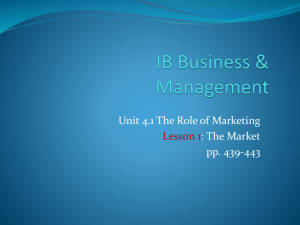
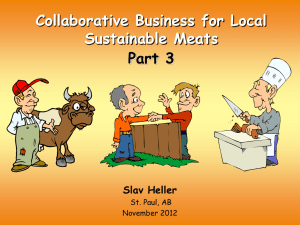
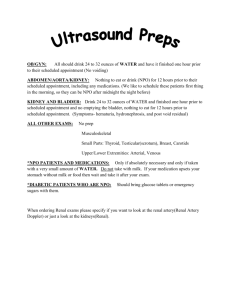

![Crisis Communication[1] - NorthSky Nonprofit Network](http://s2.studylib.net/store/data/005428035_1-f9c5506cadfb4c60d93c8edcbd9d55bf-300x300.png)
